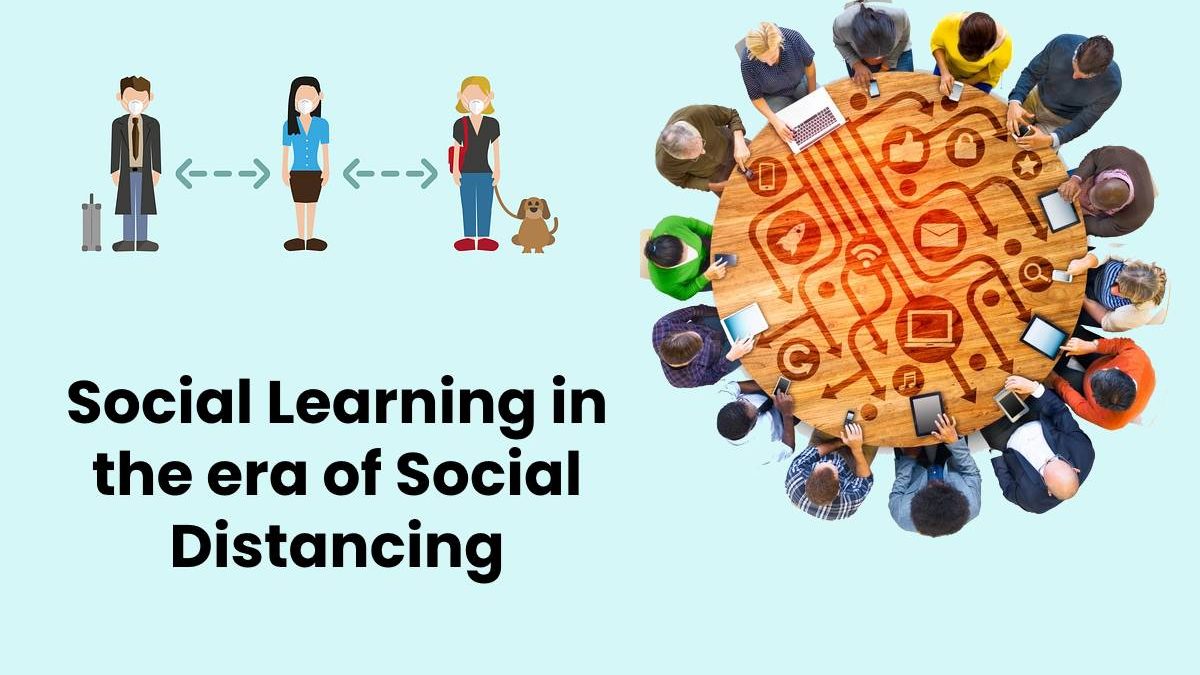Social Learning in the era of Social Distancing
Table of Contents
Bridging the gap between Synchronous and Asynchronous Training
Introduction
‘Being Social’ is an innate characteristic bestowed upon humankind since its inception.
Living in groups and learning from the surroundings through observation and collaboration is a natural phenomenon for the human race. This has helped us condition our minds and improve our skills over centuries, thus making us the ultra-modern Homosapiens that we are today.
Today as we constantly strive for perpetual growth and continue to learn and pick up traits from the people around us, social learning has entwined as a part of our DNA.
What is Social Learning?
Have you ever been inspired by corporate success stories? Do you seek guidance from colleagues while troubleshooting? Do self-help books grab your attention?
If the answer is ‘yes’, then Social Learning is already your trait.
Social learning is defined as learning that happens through the observation of other people’s actions. It is an amalgamation of cognitive and behaviour learning.
It can be a one-way process in terms of learning through observation, listening, analysing and imbibing selective behaviour/ knowledge of an individual without the other person being aware. Else, it can be a two way process where both the learner and the influencer are involved in a formal or informal way.
Theory of Social Learning
Various scientists have worked on the theory of Social Learning, however, the work done by a Canadian-born American psychologist; Albert Bandura, is the most popular theory. He suggested that people do not merely learn through observation, but motivation and relevance play a key role in Social Learning.
Four principles of Bandura’s social learning theory
To support his theory Albert Bandura introduced four principles to bridge behavioural and cognitive Social Learning:
- Attention – A person will only focus on particular behaviour, thought or idea only if it is appealing to the individual.
- Retention – An information – in this case a conceived thought/ knowledge/ idea or behaviour is usually stored in a dormant state internally and will be recalled only when one needs to respond to a similar situation in the future.
- Reproduction – Retained information can be reproduced whenever required, however constant reproduction of information helps in better response.
- Motivation – It can be intrinsic or extrinsic. Motivation towards utilizing or processing an information initiates from observing others being rewarded or punished for similar action or behaviour
Social Learning at Workplace
Skill development of the staff through formal training is a constant endeavour of L&D. However, social interactions, learning through observation and exchange of information amongst colleagues have been the most underrated yet significant learning tools. Nonetheless, with changing dynamics in work-culture especially due to global pandemic, Social Learning has been of utmost importance like never before.
Advantages of Social Learning
As the new age Millennials and Gen Zs look forward to Collaboration over Competition, Social Learning is more appealing and beneficial in various ways:
1) Increased engagement
Through formal and informal training methods, social learning breaks the communication barrier between the learner and trainer; thus facilitating better understanding and knowledge sharing.
2) Holistic Development
As social learning involves observation, perception, analysis and self-learning along with knowledge sharing, it encourages professional, cognitive and behavioural development.
3) Cost Effectiveness
Besides reducing monetary burden on training, social learning further ensures complete utilization of Human Resource to its full potential, increase in ROI, motivation and retention in staff through rewards, responsibility, recognition and upskilling.
4) Multi-modalities and channels
Social learning, expands number of learning avenues and options for the employees
How to implement Social learning in Corporate L&D?
Companies are striving earnestly to revamp their existing learning model by discarding obsolete and irrelevant training methodologies and adapting need based alternatives.
Limited funds, lack of IT proficiency amongst trainers/SMEs, reachability to larger audience and generic content are some challenges that hinder effective implementation of social learning, especially in mid and small organizations.
Employee Generated Learning (EGL) is a simple solution to the above-mentioned problems.
It’s a classic bottom-up approach, entirely driven by employees and often known to save time and effort of L&D. It is a combination of synchronous and asynchronous learning, with emphasis on quality training within available resources.
It involves empowering the existing subject matter experts, experienced employees and staff with crucial expertise, to share their knowledge, tactics and skills to the desired set of learners.
Key determinants towards effective implementation of EGL
a) Stakeholder Buy In
Any model seeps into the system only if the stakeholders and top authorities are convinced in the first place. Stakeholder buy-in is therefore the first step towards EGL implementation.
EGL helps provide user flexibility, maximum outcome with minimum input, better outreach, facilitates time management, budget friendly, increases return of Investment and therefore ticks all the boxes desired by the stakeholders.
b) L&D ‘s role
The L & D team is the flag bearer in implementation of e-learning including EGL. They are involved in planning, execution and analysis of the entire e-learning activity. They identify the organizational gaps and needs and design training accordingly. In addition to the usual responsibilities, L&D is required to facilitate the content creation process by guiding and liaising with the subject matter experts.
c) Employee’s role
Employees form the foundation of the entire process as ultimately the idea and implementation of EGL is – of the employee, by the employee and for the employee. Here, employees create their own content and share it with their peers. This content is the ultimate form of tactical business knowledge that L&D often falls short of. Subject Matter Experts (SME) drive this process end to end from create, collaborate and share content with learners using authoring tools such as Easygenerator.
d) Content Creation – Tools
Content is the king in every sector. With good content creation tools at your disposal, implementation of EGL is a cakewalk.
E-learning content creating tools such as Easygenerator enables anyone, from e-learning professionals to subject-matter experts to create, collaborate and share interactive content with multiple authors in real-time. Its pre-made templates and drag and drop editor creates seamless and a variety of content (multimedia, powerpoint, quizzes, documents and many more) within no time. It further helps in tracking results to give an insight into the learner’s performance. It is an easy-to-use tool that does not require any specialised skills or IT background.
Conclusion
Social Learning is a refreshing and a welcoming alternative to the dogmatic, redundant old school traditional learning methods. With vast scope and flexibility, collaborative social learning is on point training model for the new age companies and their new age employees.
About the author

Videhi Bhamidi is a Principal Strategist overseeing the Didactics and Discovery projects at Easygenerator. With over 15 years of experience in e-learning, user-experience research, and thought-leadership projects, she is a regular contributor to L&D magazines. She is an Oxford alumnus and strives to fuse design, research, technology, and didactics in her solutions

